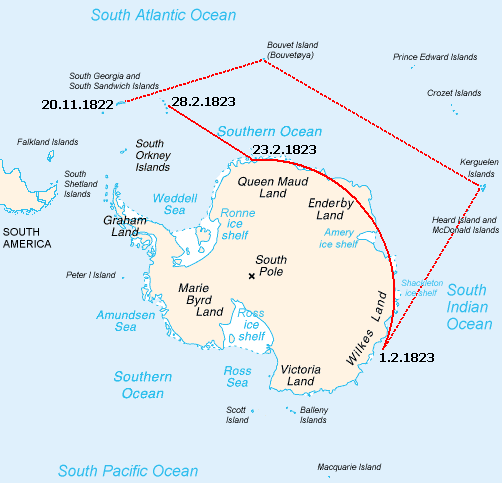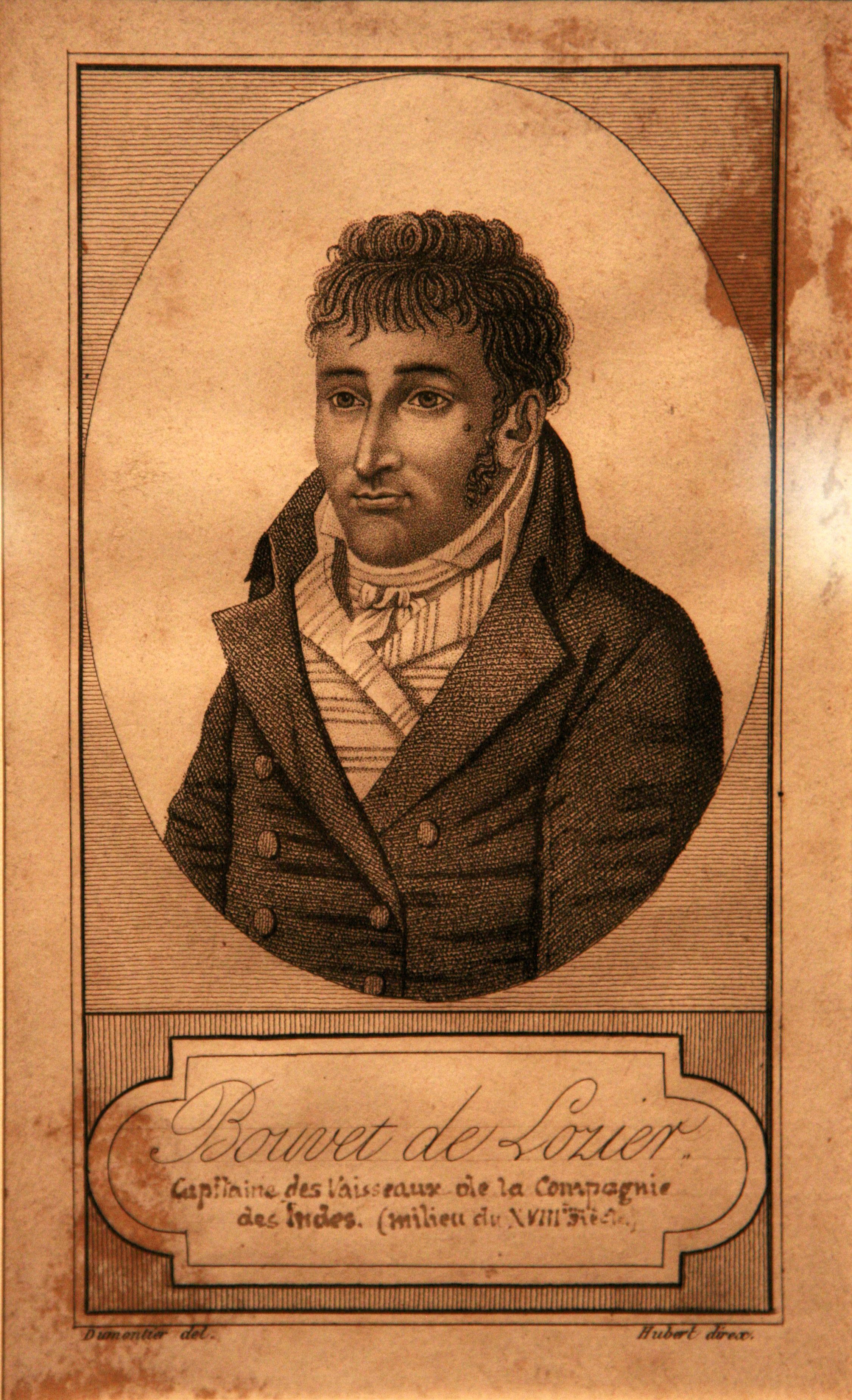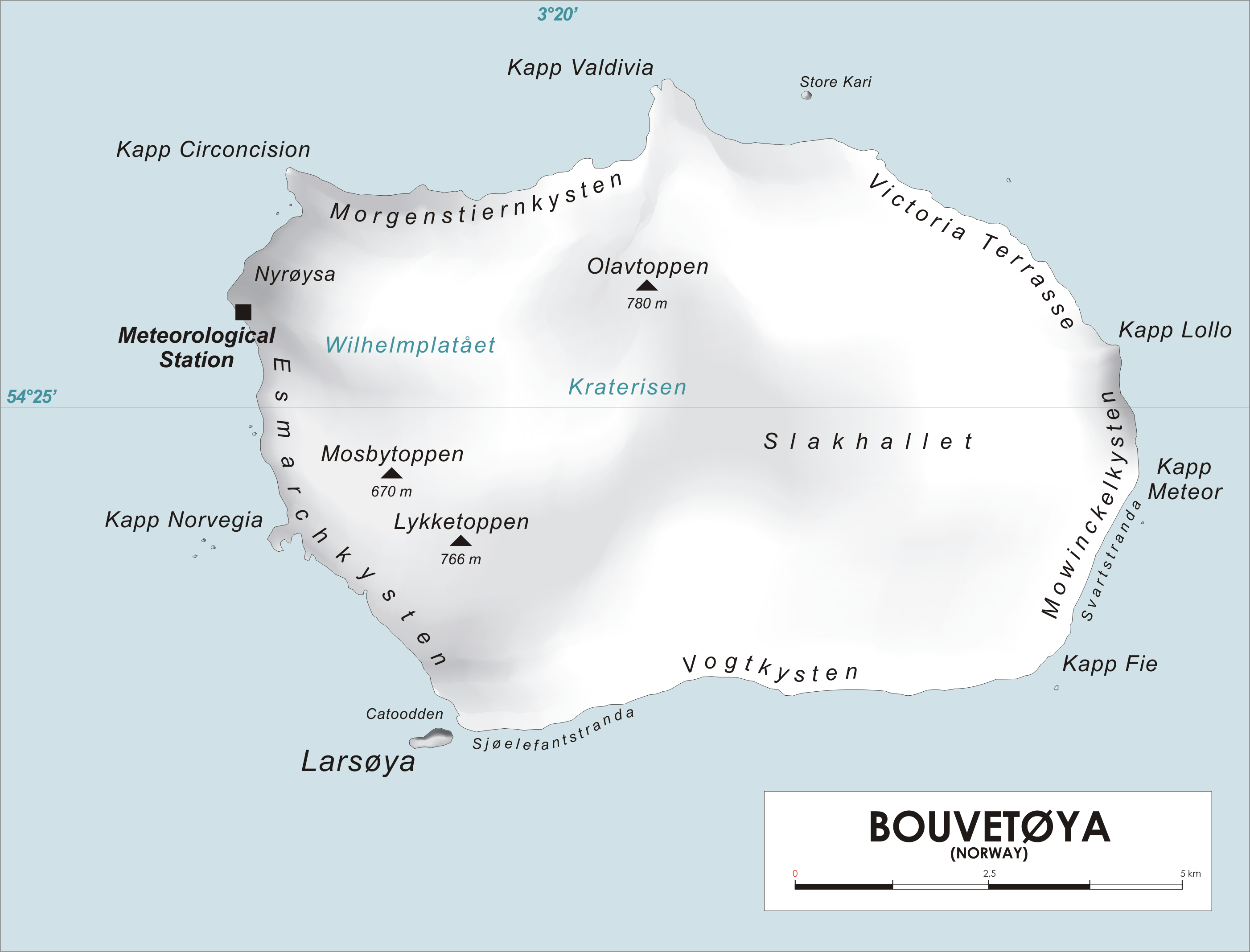|
Bouvet Island
Bouvet Island ( ; or ''Bouvetøyen'') is an island claimed by Norway, and declared an uninhabited protected nature reserve. It is a subantarctic volcanic island, situated in the South Atlantic Ocean at the southern end of the Mid-Atlantic Ridge, making it the world's most remote island. It is not part of the southern region covered by the Antarctic Treaty System. The island lies north of the Princess Astrid Coast of Queen Maud Land, Antarctica, east of the South Sandwich Islands, south of Gough Island, and south-southwest of the coast of South Africa. It has an area of , 93 percent of which is covered by a glacier. The centre of the island is the ice-filled crater of an inactive volcano. Some skerries and one smaller island, Larsøya, lie along its coast. Nyrøysa, created by a rock slide in the late 1950s, is the only easy place to land and is the location of a weather station. The island was first spotted on 1 January 1739 by the Frenchman Jean-Baptiste Cha ... [...More Info...] [...Related Items...] OR: [Wikipedia] [Google] [Baidu] |
Dependencies Of Norway
Norway has three dependent territories ( no, biland), all uninhabited and located in the Southern Hemisphere. Bouvet Island (Bouvetøya) is a sub-Antarctic island in the South Atlantic Ocean. Queen Maud Land is a sector of Antarctica which spans between the 20th meridian west and the 45th meridian east. Peter I Island is a volcanic island located off the coast of Ellsworth Land of continental Antarctica. Svalbard is not formally considered to be a dependency. While the Svalbard Treaty regulates some aspects of that Arctic territory, one article acknowledges that these islands are part of Norway. Similarly, Jan Mayen is recognized as an integral part of the nation. Both are unincorporated areas. Both Peter I Island and Queen Maud Land are south of 60°S and are thus part of the Antarctic Treaty System. While the treaty states that the claims are not affected by the treaty, only the other countries with claims recognize Norwegian sovereignty on the island. The dependencies are a ... [...More Info...] [...Related Items...] OR: [Wikipedia] [Google] [Baidu] |
Gough Island
upright=1.3, Map of Gough island Gough Island ( ), also known historically as Gonçalo Álvares, is a rugged volcanic island in the South Atlantic Ocean. It is a dependency of Tristan da Cunha and part of the British overseas territory of Saint Helena, Ascension and Tristan da Cunha. It is about south-east of the Tristan da Cunha archipelago (which includes Nightingale Island and Inaccessible Island), north-east from South Georgia Island, west from Cape Town, and over from the nearest point of South America. Gough Island is uninhabited, except for the personnel of a weather station (usually six people) that the South African National Antarctic Programme has maintained, with British permission, continually on the island since 1956. It is one of the most remote places with a constant human presence. It is part of the UNESCO World Heritage Site of "Gough and Inaccessible Island". It is one of the most important seabird colonies in the world. Name The island was first named '' ... [...More Info...] [...Related Items...] OR: [Wikipedia] [Google] [Baidu] |
Hjalmar Riiser-Larsen
Hjalmar Riiser-Larsen (7 June 1890 – 3 June 1965) was a Norwegian aviation pioneer, military officer, polar explorer and businessman. Among his achievements, he is generally regarded a founder of the Royal Norwegian Air Force. Background Riiser-Larsen was born in Kristiania, Norway. In 1909, aged nineteen, he joined the Norwegian Naval Academy. In 1915 he became a 1st lieutenant in the newly formed Royal Norwegian Navy Air Service (RNoNAS). After World War I, he served as the acting head of the RNoNAS's factory until a more senior officer was appointed. In 1921, he joined the Aviation Council, then part of the Norwegian Ministry of Defence, as a secretary. This gave him the opportunity to study the fledgling military and civil aviation infrastructure for which the council was responsible. He also became a frequent pilot on the air routes used by the new aviation companies. Polar exploration Flying over the North Pole Riiser-Larsen's years of polar exploration began in 19 ... [...More Info...] [...Related Items...] OR: [Wikipedia] [Google] [Baidu] |
Phantom Island
A phantom island is a purported island which was included on maps for a period of time, but was later found not to exist. They usually originate from the reports of early sailors exploring new regions, and are commonly the result of navigational errors, mistaken observations, unverified misinformation, or deliberate fabrication. Some have remained on maps for centuries before being "un-discovered." Unlike lost lands, which are claimed (or known) to have once existed but to have been swallowed by the sea or otherwise destroyed, a phantom island is one that is claimed to exist contemporaneously, but later found not to have existed in the first place (or found not to be an island, as with the Island of California). Examples Some may have been purely mythical, such as the Isle of Demons near Newfoundland, which may have been based on local legends of a haunted island. The far-northern island of Thule was reported to exist by 4th century BCE Greek explorer Pytheas, but informati ... [...More Info...] [...Related Items...] OR: [Wikipedia] [Google] [Baidu] |
Thompson Island (South Atlantic)
Thompson Island was a phantom island in the Atlantic Ocean, South Atlantic. It was thought to be about north-northeast of Bouvet Island, a small Norway, Norwegian Dependent territory, dependency between South Africa and Antarctica. History The island was first reported and named by Whaler, whaling ship Sea captain, captain George Norris in 1825, supposedly the same day as sighting and landing on Bouvet Island, erroneously thinking the island to be undiscovered and naming it Liverpool Island. The last reported sighting was in 1893. When, however, the German Empire, German Survey vessel, survey ship ''Valdivia'' fixed the position of Bouvet in 1898, it then looked for Thompson, but did not find it. If Thompson ever existed, it is probable that it disappeared in a Volcano, volcanic eruption sometime in the 1890s, though in 1997 it was reported that the sea depth at the supposed location is greater than , rendering the existence of a submarine volcano all but impossible. Thompson ... [...More Info...] [...Related Items...] OR: [Wikipedia] [Google] [Baidu] |
British Crown
The Crown is the state (polity), state in all its aspects within the jurisprudence of the Commonwealth realms and their subdivisions (such as the Crown Dependencies, British Overseas Territories, overseas territories, Provinces and territories of Canada#Provinces, provinces, or states and territories of Australia, states). Legally ill-defined, the term has different meanings depending on context. It is used to designate the monarch in either a personal capacity, as Head of the Commonwealth, or as the king or queen of their realms (whereas the monarchy of the United Kingdom and the monarchy of Canada, for example, are distinct although they are in personal union). It can also refer to the rule of law; however, in common parlance 'The Crown' refers to the functions of executive (government), government and the civil service. Thus, in the United Kingdom (one of the Commonwealth realms), the government of the United Kingdom can be distinguished from the Crown and the state, in prec ... [...More Info...] [...Related Items...] OR: [Wikipedia] [Google] [Baidu] |
Benjamin Morrell
Benjamin Morrell (July 5, 1795 – 1838 or 1839?) was an American sea captain, explorer and trader who made a number of voyages, mainly to the Atlantic, the Southern Ocean and the Pacific Islands. In a ghost-written memoir, ''A Narrative of Four Voyages'', which describes his sea-going life between 1823 and 1832, Morrell included numerous claims of discovery and achievement, many of which have been disputed by geographers and historians, and in some cases have been proved false. He ended his career as a fugitive, having wrecked his ship and misappropriated parts of the salvaged cargo. Morrell had an eventful early career, running away to sea at the age of 17 and being twice captured and imprisoned by the British during the War of 1812. He subsequently sailed before the mast for several years before being appointed as chief mate, and later as captain, of the New York sealer ''Wasp''. In 1823 he took ''Wasp'' for an extended voyage into subantarctic waters, and on his return made u ... [...More Info...] [...Related Items...] OR: [Wikipedia] [Google] [Baidu] |
Whaler
A whaler or whaling ship is a specialized vessel, designed or adapted for whaling: the catching or processing of whales. Terminology The term ''whaler'' is mostly historic. A handful of nations continue with industrial whaling, and one, Japan, still dedicates a single factory ship for the industry. The vessels used by aboriginal whaling communities are much smaller and are used for various purposes over the course of the year. The ''whale catcher'' was developed during the age of steam, and then driven by diesel engines throughout much of the twentieth century. It was designed with a harpoon gun mounted at its bow and was fast enough to chase and catch rorquals such as the fin whale. At first, whale catchers either brought the whales they killed to a whaling station, a settlement ashore where the carcasses could be processed, or to its factory ship anchored in a sheltered bay or inlet. With the later development of the slipway at the ship's stern, whale catchers were able ... [...More Info...] [...Related Items...] OR: [Wikipedia] [Google] [Baidu] |
South Atlantic
The Atlantic Ocean is the second-largest of the world's five oceans, with an area of about . It covers approximately 20% of Earth's surface and about 29% of its water surface area. It is known to separate the " Old World" of Africa, Europe and Asia from the "New World" of the Americas in the European perception of the World. The Atlantic Ocean occupies an elongated, S-shaped basin extending longitudinally between Europe and Africa to the east, and North and South America to the west. As one component of the interconnected World Ocean, it is connected in the north to the Arctic Ocean, to the Pacific Ocean in the southwest, the Indian Ocean in the southeast, and the Southern Ocean in the south (other definitions describe the Atlantic as extending southward to Antarctica). The Atlantic Ocean is divided in two parts, by the Equatorial Counter Current, with the North(ern) Atlantic Ocean and the South(ern) Atlantic Ocean split at about 8°N. Scientific explorations of the Atlanti ... [...More Info...] [...Related Items...] OR: [Wikipedia] [Google] [Baidu] |
Jean-Baptiste Charles Bouvet De Lozier
Jean-Baptiste Charles Bouvet de Lozier (14 January 1705 – 1786) was a French sailor, explorer, and governor of the Mascarene Islands. He was orphaned at the age of seven and after being educated in Paris, he was sent to Saint Malo to study navigation. He became a lieutenant of the French East India Company in 1731. He succeeded in convincing his employer to provide him with two ships and send him on an exploration mission in the South Atlantic. With his ships ''Aigle'' and ''Marie'' he discovered on 1 January 1739 a tiny island which was named Bouvet Island after him; however, he mislabeled the coordinates for the island, causing it to be lost until it was rediscovered seven decades later in 1808. Shortly afterwards, he had to abandon the expedition because most of his crew had fallen ill; his ship then called at the Cape of Good Hope and returned to France. Ten years after his expedition, Bouvet de Lozier was appointed governor of the Mascarene Islands The Mascarene Islan ... [...More Info...] [...Related Items...] OR: [Wikipedia] [Google] [Baidu] |
Weather Station
A weather station is a facility, either on land or sea, with instruments and equipment for measuring atmospheric conditions to provide information for weather forecasts and to study the weather and climate. The measurements taken include temperature, atmospheric pressure, humidity, wind speed, wind direction, and precipitation amounts. Wind measurements are taken with as few other obstructions as possible, while temperature and humidity measurements are kept free from direct solar radiation, or insolation. Manual observations are taken at least once daily, while automated measurements are taken at least once an hour. Weather conditions out at sea are taken by ships and buoys, which measure slightly different meteorological quantities such as sea surface temperature (SST), wave height, and wave period. Drifting weather buoys outnumber their moored versions by a significant amount. Weather instruments Typical weather stations have the following instruments: * Thermometer for ... [...More Info...] [...Related Items...] OR: [Wikipedia] [Google] [Baidu] |
Larsøya
Larsøya, sometimes anglicized as Lars Island, is a rocky island, less than long, which lies just off the southwestern extremity of the island of Bouvetøya in the South Atlantic Ocean. It was first roughly charted in 1898 by a German expedition under Carl Chun. The Norwegian expedition under Captain Harald Horntvedt made a landing on the island from the ship ''Norvegia'' in December 1927, and named it after Lars Christensen Lars Christensen (6 April 1884 – 10 December 1965) was a Norwegian shipowner and whaling magnate. He was also a philanthropist with a keen interest in the exploration of Antarctica. Career Lars Christensen was born at Sandar in Vestfold, Norw ..., sponsor of the expedition. See also * List of Antarctic and subantarctic islands References Landforms of Bouvet Island {{BouvetIsland-geo-stub ... [...More Info...] [...Related Items...] OR: [Wikipedia] [Google] [Baidu] |






.jpg)




